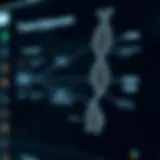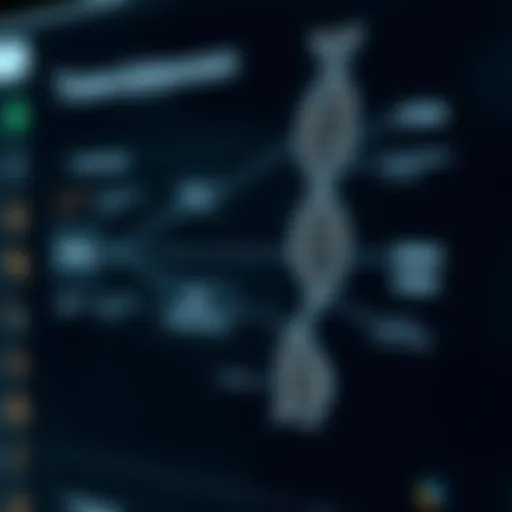Innovations in Skin Closure Devices and Their Impact


Intro
Skin closure devices represent a critical element of surgical procedures. Their effective use not only influences the recovery process but also impacts overall patient outcomes. This article explores various skin closure devices, focusing on what they are, how they function, and their relevance across multiple medical fields. By understanding these devices, healthcare professionals can make informed choices tailored to specific surgical contexts.
Key Concepts and Terminology
Definition of Key Terms
Before delving deeper, it is vital to clarify essential terms associated with skin closure devices:
- Skin Closure Devices: These are tools used to approximate and secure the edges of a surgical incision or wound.
- Surgical Adhesives: Biological adhesives that bond skin edges together, often reducing the need for traditional stitches.
- Staplers: Specialized instruments that place metal or plastic staples to close wounds.
- Wound Dressings: Protective coverings placed over wounds to promote healing and prevent infection.
Concepts Explored in the Article
This article discusses several concepts related to skin closure devices:
- Mechanisms of Action: It will examine how these devices function, from adhesives to sutures.
- Efficacy and Safety: Investigating both benefits and potential complications associated with different types of closure methods.
- Technological Advancements: Highlighting recent innovations in the field and how they affect surgical practice and outcomes.
Findings and Discussion
Main Findings
Skin closure devices have shown significant advancements. Recent research indicates that modern adhesives offer comparable strength to traditional sutures, reducing scarring.
Furthermore, instruments like the Ethicon Endo-Surgery stapler demonstrate efficiency in rapid skin closure, thus minimizing surgical time and potential complications. However, choices depend on the nature of surgeries and patient factors.
Potential Areas for Future Research
As technology continues to evolve, several areas present opportunities for further investigation that may provide insight into skin closure devices:
- Long-Term Efficacy: Understanding the durability and outcomes of adhesive methods versus traditional sutures over a longer period.
- Cost-Effectiveness Studies: Evaluating the economic impacts of various closure devices on healthcare systems.
- Patient Satisfaction: Researching how different closure techniques impact not only healing but also psychological well-being post-surgery.
As the field develops, integrating innovative skin closure technology within clinical settings remains vital for improving surgical practice.
Prelims to Skin Closure Devices
Skin closure devices are integral to surgical practice. They play a crucial role in wound approximation, which is essential for proper healing. Understanding these devices enhances a practitioner’s ability to choose the correct method for various surgical situations.
Through this analysis, we aim to uncover not only the mechanics of these devices but also their historical context, evolution, and future trends. With advancements in medical technology, the landscape of skin closure is constantly changing. Knowledge of the past and present can better inform decisions in clinical practice.
Definition and Purpose
Skin closure devices are tools used to close wounds or incisions made during surgical procedures. They help approximate skin edges, thereby facilitating healing while also minimizing complications.
The primary purpose is two-fold:
- To promote optimal healing by providing a secure closure that protects the underlying tissues.
- To reduce the risk of infection and minimize scarring.
Different devices cater to various types of wounds, from small lacerations to larger surgical cuts. The choice of a device can depend on factors such as the location of the wound, the tension required, and the type of tissue involved.
Historical Development
The history of skin closure is as old as surgery itself. Early methods included sutures made from natural materials, such as animal intestines and silk. These rudimentary techniques evolved significantly over centuries.
In the 19th century, the advent of antiseptics changed how surgical wounds were closed, improving patient outcomes through reduced infection rates. During the 20th century, innovations such as staples and adhesive strips became common.
Today, the field is witnessing the emergence of biodegradable devices and smart technology integrated into closure systems. These developments reflect a growing understanding of wound healing and patient-centered care.
"An informed selection of skin closure device can significantly influence surgical outcomes."
In summary, an exploration of skin closure devices encompasses their definition, purpose, and rich historical development, setting a foundational understanding for the subsequent sections.


Types of Skin Closure Devices
Skin closure devices are essential tools in the surgical setting. Their proper understanding can significantly affect patient outcomes, wound healing, and the overall success of surgical procedures. In this section, we will examine various types of skin closure devices. Each type has its unique advantages, disadvantages, and applications that make it suitable for different clinical scenarios.
Sutures
Sutures have been the traditional method for wound closure. They can be absorbable or non-absorbable and are used in various types of surgeries. The choice of sutures depends on the tissue type and the desired closure technique. Absorbable sutures are often used internally, as they dissolve over time, while non-absorbable sutures are used for external closures where they may need removal later.
The skill of the surgeon in placing sutures is crucial for ensuring optimal tension and alignment of the wound edges, which influences healing. Sutures, while effective, may also carry risks including infection and scarring.
Staples
Staples are another widely used method for skin closure. They are especially beneficial for larger incisions where sutures may not provide sufficient strength. Staples can save time during surgery, contributing to improved efficiency, and often lead to lower postoperative complications.
While staples can be quick to apply and provide good strength, they can also lead to discomfort for the patient. They are typically removed during follow-up care, raising considerations for patient compliance.
Adhesive Strips
Adhesive strips, such as Steri-Strips, are a less invasive option for wound closure. They are often employed for minor cuts and surgical incisions where minimal tension is required. This type provides a simple and effective means of approximating wound edges.
Adhesive strips are favored for their ease of use. They require no special training for application and can be used in outpatient settings. However, they are limited to less severe wounds and may not offer the same level of support as sutures or staples.
Tissue Adhesives
Tissue adhesives are a newer class of skin closure devices. Cyanoacrylate adhesives bond tissue together, acting as a sealant that protects wounds from contaminants. These adhesives can be especially useful for pediatric patients or in areas where traditional closure methods may be challenging.
Advantages include reduced application time and less risk of needle-related injuries. However, the effectiveness of tissue adhesives can be influenced by the type of tissue, moisture levels, and the nature of the wound, which must be carefully considered.
Biodegradable Devices
Biodegradable devices are a novel development in skin closure technology. They provide a temporary means of closure while promoting wound healing. As these devices dissolve, they become part of the biological environment of the wound, which can be beneficial for healing.
The key benefits may include reduced need for follow-up procedures associated with suture removal. As with any technology, it is essential to assess the appropriate use cases to match the specific needs of the patient and the clinical situation.
In summary, understanding the various types of skin closure devices influences surgical practices and patient care. Each option presents specific characteristics that can enhance or hinder recovery and should be chosen based on individualized patient needs.
Mechanisms of Action
Understanding the mechanisms of action behind skin closure devices is crucial for evaluating their effectiveness in various surgical procedures. This section will detail the principles of tissue approximation and the biological response to the closure, which together form the foundation for successful wound healing. Knowledge of these mechanisms allows healthcare professionals to select the most suitable closure technique based on the type of wound and patient needs.
Principles of Tissue Approximation
Tissue approximation refers to the method by which the edges of a wound are brought together to facilitate healing. The primary goal is to minimize the gap between these edges, thus reducing the distance that new tissue must cover. Proper approximation serves several important functions:
- Reduces tension on the wound edges, which is essential in preventing dehiscence, a condition where the wound reopens.
- Optimizes blood supply to the healing tissue, aiding in the natural repair processes.
- Creates a barrier against infection, as closely approximated tissues can limit the space where pathogens might enter.
In practice, different devices, like sutures and staples, achieve tissue approximation using distinct mechanisms. Sutures interlace tissue edges through a continuous or interrupted pattern, while staples quickly secure edges through mechanical fastening. The choice between these methods often depends on the specific anatomical location and the characteristics of the tissue involved.
Biological Response to Closure
The biological response to skin closure involves a series of complex physiological processes that are triggered upon wounding. When skin is disrupted, the body initiates a cascade of healing responses:
- Hemostasis – The first step helps prevent bleeding through the constriction of blood vessels and clot formation.
- Inflammation – This phase involves immune cells migrating to the site to prevent infection and clear debris.
- Proliferation – New tissue forms as fibroblasts generate collagen, which provides strength to the healing wound.
- Maturation – The final phase where tissue remodels over time, achieving its optimal structure and function.
Effective skin closure devices facilitate this biological response by ensuring that wound edges are aligned properly. This alignment not only enhances the aesthetics of the final scar but also plays a significant role in how well the wound will heal. Understanding this biological underpinning is essential in selecting appropriate closure methods, as improper closure can lead to complications, including infection and poor scarring.
A thoughtful selection of skin closure devices, based on an awareness of tissue approximation and biological healing responses, can markedly improve patient outcomes.
Clinical Applications
Skin closure devices play a crucial role in various surgical settings. Their proper choice and application affect surgical outcomes and recovery times for patients. Understanding the clinical applications of these devices allows for better decision-making by healthcare providers, ultimately enhancing patient care.
General Surgery


In general surgery, skin closure devices are essential for various procedures, including laparotomies and other abdominal surgeries. The choice between sutures, staples, and adhesive strips can significantly alter wound healing and patient recovery. Sutures provide strength and flexibility but require skill in technique. Staples, though quicker to apply, can present issues with patient comfort and may cause more scarring. Adhesive strips offer a less invasive method but may not be suitable for high-tension wounds.
Dermatological Surgery
Dermatological surgery often involves delicate skin incisions. Skin closure devices used here need to minimize scarring and maintain cosmetic outcomes. Tissue adhesives, for instance, are increasingly used due to their ease of application and ability to provide a seamless finish. However, sutures remain prevalent for larger excisions. The considerations for closure in dermatology are often more aesthetic, making the choice of device critical to achieving satisfactory results for patients.
Orthopedic Surgery
In orthopedic surgery, skin closure devices must accommodate the specific needs of the procedure. Surgeons often prefer strong closure methods to ensure wound integrity during healing, especially in weight-bearing areas. Staples and sutures are commonly used in this field. The material used for sutures can also impact healing, with absorbable options providing ease and non-absorbable options offering durability when needed. Proper closure technology is vital in orthopedic procedures to prevent complications like infections or delayed healing.
Pediatric Applications
Pediatric applications of skin closure devices present unique challenges. Children have thinner skin and different healing processes than adults. As such, the choice of device should not only consider efficacy but also patient comfort. Adhesive strips are often favored for minor procedures because they are less traumatic and allow for quicker recovery. For larger incisions, care must be taken to choose methods that minimize discomfort and scarring, as children are more sensitive to cosmetic outcomes.
"The effective selection of skin closure devices can dramatically influence patient recovery and satisfaction."
In summary, the clinical applications of skin closure devices underscore their importance across different surgical fields. Each type has its strengths and weaknesses relevant to specific procedures, patient demographics, and desired outcomes. Understanding these nuances is essential for optimizing patient care.
Advantages of Skin Closure Devices
Skin closure devices play a pivotal role in surgical practices. Their primary aim is to ensure that wounds heal efficiently. When properly used, these devices can enhance patient recovery and overall outcomes. This section will analyze specific advantages provided by skin closure devices, highlighting improved wound healing, reduced infection rates, and minimized scarring.
Improved Wound Healing
One fundamental benefit of skin closure devices is their ability to promote wound healing. Devices like sutures, staples, and adhesive strips create a seamless barrier over the wound. This barrier is essential in minimizing the exposure of underlying tissues to external contaminants. Additionally, proper tissue approximation is crucial in the healing process.
When soft tissues are well-aligned, cells can migrate efficiently to repair the tissue, leading to faster healing times. Studies show that optimized wound closure techniques can greatly reduce complication rates. For example, the use of advanced tissue adhesives may even lead to better outcomes in certain surgical applications.
Reduced Infection Rates
Infection remains one of the biggest risks in wound management. Skin closure devices help mitigate this risk significantly. By closing the wound, they reduce the likelihood of bacteria entering the injury site. Sutures and staples, when applied correctly, can help keep the edges of the wound together, which creates a physical barrier.
Using devices like Dermabond instead of traditional sutures can also reduce the infection rate. These adhesives do not require puncturing the skin, which can minimize the introduction of pathogens. Better closure techniques can directly influence an overall reduction in postoperative infection rates, increasing the safety of surgical procedures.
Minimized Scarring
Cosmetic outcomes are an important consideration in wound management, especially for surgeries in visible areas. Skin closure devices can significantly influence the post-operative scarring. Devices that offer precise wound approximation can reduce tension on the skin, which is crucial for optimal healing. Less tension generally means better cosmetic results.
Adhesive strips, for instance, allow for a gentle closure without the bulkiness of stitches that can pull on the skin. Additionally, the use of absorbable sutures can eliminate the need to remove stitches, reducing the trauma and potential for scarring.
"Choosing the right skin closure device can dramatically improve final aesthetic results, affecting patient satisfaction and overall quality of life."
In summary, the advantages of skin closure devices are manifold. They improve wound healing processes, reduce infection risks, and minimize the appearance of scars. Awareness of these benefits is essential for healthcare professionals and can lead to better clinical decisions regarding patient care.
Challenges and Limitations
The utilization of skin closure devices is not without its challenges and limitations. Understanding these issues is vital for surgeons, medical professionals, and researchers alike. This section aims to illuminate the specific complications that may arise from the use of these devices, as well as the factors affecting patient compliance and satisfaction.
Complications Associated with Skin Closure
Skin closure devices can sometimes lead to complications that may affect patient outcomes. These complications can be categorized into several types:
- Infection: One of the most significant risks associated with skin closure devices is infection. Bacteria can colonize the area around a wound, especially if the device is not applied correctly or if the wound is not properly cleaned beforehand.
- Dehiscence: This term refers to the reopening of a wound after it has begun to heal. Dehiscence can occur for various reasons, including excessive movement of the site, inadequate skin tension, or poor tissue quality.
- Scarring: While some skin closure devices aim to minimize scarring, they can sometimes exacerbate it, resulting in poor aesthetic outcomes. Scarring is a considerable concern for patients, especially in visible areas.
- Allergic Reactions: Some individuals may have allergies to materials used in skin closure devices, such as adhesives or suture materials. This can lead to inflammation and further complicate the healing process.
These factors highlight the need for careful consideration when selecting skin closure methods, as they can significantly impact not just the efficacy of the healing process but also the overall patient experience.
Patient Compliance and Satisfaction
Another critical aspect in the assessment of skin closure devices is patient compliance and satisfaction. The success of any medical intervention often hinges on how well patients adhere to post-operative care instructions. Several elements can influence patient compliance:
- Ease of Use: Devices that are straightforward for patients to understand and apply yield higher compliance rates. If a patient struggles with managing their skin closure device, they are less likely to follow the recommended protocols.
- Education: Clear and thorough education about the purpose of the device and its proper maintenance plays a pivotal role. Patients who understand how their compliance impacts their recovery are generally more willing to engage with their care plans.
- Comfort: Devices that cause discomfort or irritation can lead to decreased adherence. If the patient experiences pain or inconvenience, they may avoid using the closure method as advised.
- Visualization of Healing: When patients can easily assess their healing progress, they often feel a sense of ownership over their recovery, which can result in better adherence to care instructions.


Recent Innovations in Skin Closure Devices
Recent developments in the field of skin closure devices have marked significant advancements in surgical procedures and patient care. As technologies evolve, the importance of these innovations becomes increasingly evident. The integration of new techniques into clinical practice is essential for improving outcomes, minimizing complications, and providing patients with safer options. By focusing on elements such as usability, efficacy, and patient comfort, recent innovations aim to address many of the limitations associated with traditional skin closure methods.
The impact of these advancements extends to various aspects of patient care, demonstrating potential benefits across different surgical disciplines. Improved wound healing, lower infection rates, and enhanced patient satisfaction are among the notable advantages linked to these modern devices. Considerations around cost and accessibility also play a crucial role, influencing the adoption of these innovations into everyday clinical settings. As healthcare professionals strive for excellence in patient outcomes, understanding these innovations is imperative.
Smart Closure Devices
Smart closure devices are at the forefront of modern surgical technology. These devices incorporate sensors and data analytics to monitor wound conditions in real-time. By tracking variables such as temperature, moisture, and tension, they provide valuable feedback to healthcare providers. This information can guide decisions for timely interventions, reducing the risk of complications like infections or delayed healing.
Key benefits of smart closure devices include:
- Real-Time Monitoring: Continuous assessment of the wound environment helps in prompt identification of problems.
- Data-Driven Decisions: Analytics can inform clinical decisions, allowing tailored patient care based on individual wound response.
- Patient Engagement: Some devices enable patients to access their wound metrics, promoting awareness and compliance in their recovery process.
Despite these advantages, there are challenges to consider. The initial costs of implementing smart closure technologies may be high. Also, training users to interpret data accurately is crucial to harnessing their full potential. Nevertheless, the rise of smart devices signifies a shift towards more personalized and effective patient care.
3D Printing Technologies
3D printing technologies are revolutionizing the arena of skin closure devices. These techniques allow for the customization of devices to fit specific patient needs. Surgeons can create tailored closures based on individual anatomical requirements, enhancing comfort and efficacy.
Advantages of 3D printing in skin closure include:
- Customization: Devices can be printed to match the unique contours of a patient's body, improving the fit and function.
- Rapid Prototyping: New designs can be tested quickly, facilitating innovation in device efficiency and performance.
- Cost-Effectiveness: Reducing material waste and lowering production costs can make these devices more accessible to a wider population.
However, challenges remain in standardizing 3D printed devices for broad clinical use. Regulatory hurdles and ensuring long-term safety and efficacy are essential for widespread adoption. The benefits of 3D printing, coupled with ongoing research, indicate a promising future in skin closure technology. The integration of these innovations demonstrates an essential evolution in addressing patient needs and advancing surgical practices.
Future Directions in Skin Closure Technology
The field of skin closure devices is continuously evolving. This section explores the future directions in this crucial area of medical technology. Advancements in materials, engineering, and integration with smart systems influence the efficacy and efficiency of these devices. Understanding these changes is vital. It identifies potential improvements in patient outcomes and surgical practices.
Emerging Trends
Emerging trends in skin closure technology reveal innovative approaches that can transform surgical procedures. One significant trend is the use of biomaterials that mimic natural tissue properties. These materials promote healing while minimizing scarring. Another trend includes the development of smart closure devices. These devices can monitor wound conditions in real-time. They can alert healthcare providers to any complications, such as infection.
The focus on minimally invasive techniques adds to the trend. Surgeons are increasingly opting for approaches that minimize tissue trauma. This evolution lowers the risk of complications and enhances recovery times. As technology advances, we might see the integration of nano-technology in skin closure devices. This can lead to devices that actively participate in the healing process, delivering medication or growth factors directly to the wound site.
Integration with Advanced Healthcare Systems
Integrating skin closure devices with advanced healthcare systems is a crucial development. This integration enables better patient management. It facilitates the collection of data that can improve future surgical techniques. For example, electronic health records can be enhanced by incorporating details about the type of closure device used. This data may help providers analyze outcomes based on specific device performances.
A collaborative approach in data sharing across platforms can greatly enhance surgery outcomes. It allows healthcare professionals to make informed decisions. By connecting devices to health monitoring systems, we can develop predictive analytics that proactively address complications before they become critical.
Furthermore, telemedicine could play a role here. Remote monitoring of healing processes through connected devices can assure patients and enhance their confidence in recovery.
"Integration of technology in healthcare not only improves outcomes but also enhances the efficiency of care delivery."
As we move forward, ongoing research will likely yield distinct solutions that address current challenges. Such solutions may redefine how surgical procedures are performed, promoting more effective and personalized patient care. By staying attuned to these developments, healthcare professionals can ensure they utilize the best available technologies to enhance surgical outcomes.
The End
The conclusion of this article serves as a significant culmination of the comprehensive exploration of skin closure devices. It not only summarizes the intricate components discussed but also emphasizes the critical importance of these devices in enhancing surgical outcomes. The findings reveal several pertinent aspects regarding the mechanisms, applications, and innovations in skin closure technology.
Summary of Key Findings
In examining the fabric of this article, several key findings emerge:
- Enhancement in Wound Healing: Various devices have shown promising results in improving the rate and quality of wound healing. Techniques such as tissue adhesives and biodegradable devices minimize trauma to surrounding tissues while maintaining closure integrity.
- Reduction in Complications: Appropriate choice and application of skin closure devices can significantly lower infection rates and other complications. Strategies regarding device selection must be tailored based on the nature of the surgical procedure and patient factors.
- Technological Innovations: Recent advancements, particularly smart closure devices and 3D printing of custom closures, point towards a future where precision and adaptability in wound care are paramount. These technologies could redefine how we manage post-operative recovery and patient care.
- Patient-Centric Considerations: Addressing patient compliance and satisfaction is crucial. Understanding the patient’s perspective on skin closure methods aids clinicians in making informed choices, ultimately enhancing the overall experience.
In summary, the importance of skin closure devices transcends basic functionality; they integrate technology, surgical practice, and patient interaction into a cohesive framework aimed at optimizing health outcomes. Professionals in the medical field must continually assess and adapt their techniques to harness the full potential of these innovations.
Importance of References
- Credibility: References validate the claims made within the article. By citing peer-reviewed journals or authoritative texts, the article ensures that the information presented is substantiated by credible research. This lends weight to the narrative and fosters trust among readers.
- Research Integrity: Incorporating accurate references respects the intellectual property of original researchers. It provides proper acknowledgment and promotes ethical research practices. As skin closure devices continue to evolve, relying on previous studies is crucial for informed discussions.
- Resource for Further Study: References act as a resource for readers who wish to dive deeper into specific topics. When students, researchers, or healthcare professionals explore the references, they gain access to extended knowledge and can access empirical studies that informed the conclusions drawn in this article. This can deepen their understanding of the various intricacies involved in skin closure technology.
Considerations for References
- Selection of Sources: It’s important to select high-quality references that align with the theme of skin closure devices. Prioritize sources such as clinical studies, systematic reviews, and authoritative medical publications to enhance the overall quality of the information.
- Citation Styles: Maintain consistency in the citation style used throughout the references. Different fields of study may prefer various styles, so ensure alignment with the standards prevalent in medical research.
- Updates in the Field: Skin closure technology is continuously advancing. Keeping references up-to-date is vital to reflect the most current understanding and development in the field. This allows readers to engage with the latest innovations and research.
"References not only substantiate claims but also serve as gateways to new knowledge and understanding."







